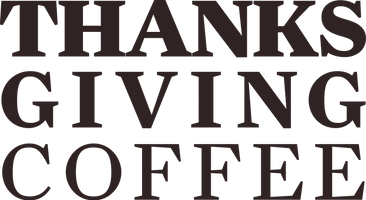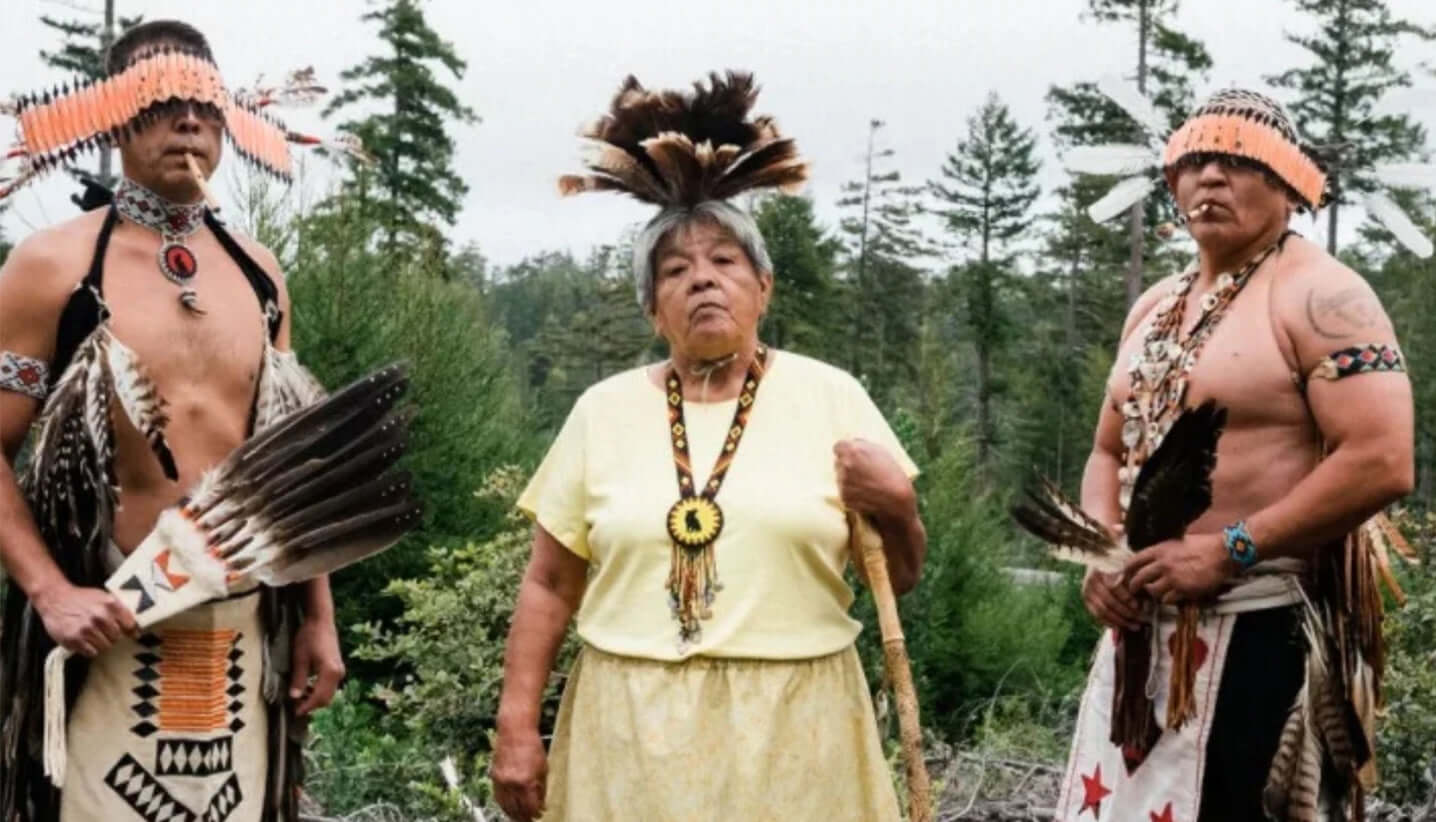
Our Blog
Pomo Possibilities
View BY :
Right Now We Are Seeing History in the Making.
In the confluence of purpose and action, our community is coming together for Tribal sovereignty and reconciliation through the Pomo Land Back movement. This is an opportunity to learn about and support the Northern Pomo People of Mendocino County. This is an opportunity to regain alignment with nature, with our community, and the indigenous people of these lands.
The parallels between the Indigenous Forest and the Indigenous People are striking. Much like the ancestral old growth Redwoods, only a fraction of the original Pomo people are still alive. Populations of Pomo tribes numbered between 13,000 - 20,000 in the early 1800s. By the 2000 census, only 5,092 Pomo were left. Likewise, only 4% of the original Redwood Forests exist, while the other 96% have been logged to extinction.
Mendocino County is home to 10 surviving Pomo tribes. All have experienced countless forms of discrimination, forced assimilation, relocation, and legal termination. It is time for the cycle to pivot. We can do this together through regeneration, cooperation, and collaboration.
What we do to the forest, we do to the people
The Pomo Tribal Leadership has identified Jackson Demonstration State Forest (JDSF) as the focus of the Pomo Land Back movement and has gathered the support of 50 California tribes across the State. This has never been achieved before. Tribal Chairman Michael Hunter is ready to lead the way for healing and has asked Governor Newsom for co-management of these forests. With the help of a strong local coalition of environmental organizations, the logging has been stopped for now.
 "Our responsibility is to past... present... and future generations of all life."
"Our responsibility is to past... present... and future generations of all life."
The way forward is to rematriate the forest and move into Indigenous stewardship. Following the lead of matriarch Priscilla Hunter, Tribal Chairman Michael Hunter is gathering the community together to bring healing and restore the biodiversity to our forests and rivers.
The 50,000 acres of Jackson State Demonstration Forests (JDSF) has been managed by Cal Fire since 1949. It is full of ancestral sacred sites, and is one of the most diverse ecosystems in the State. With the co-management plan the tribes will guide the State agencies to implement their place based knowledge and create a real demonstration forest for future generations. This irreplaceable knowledge is the expertise that has been cultivated over millennia by the tribes who have inhabited these forests.
Indigenous experts hold the wisdom of interdependence with our surroundings and how to live with the cycles of growth that will support all life. This traditional ecology knowledge (TEK) system was brutally interrupted at the time of colonization. The forest is suffering the loss of these practices and experiencing the harsh consequence of a dysfunctional system that breeds greed and exploitation.
I invite you to be a good steward of the Jackson State Demonstration Forest and learn about the Pomo Land Back movement. Together we create a new era of justice for our First Nations People of Mendocino. With Pomo leadership, Cal Fire has an opportunity to truly demonstrate what a healthy forest and healthy ecosystem is for generations to come. This is a win, win, for people, policy, and the planet. Native-led co-management of JDSF is the strongest medicine for our forests and community as a whole. I urge you to learn how you can support the stewards of this amazing forest.
To join the movement and learn more go to www.pomolandback.com.
Further Resources:
Pomo History - Encyclopedia.com
The Intertribal Sinkyone Wilderness Council
Redwood Forest Returned to Tribes
Halt Logging Northern California
The Bee Bold Alliance is a project of Thanksgiving Coffee that works to find sustainable solutions for our future generations by restoring biodiversity and supporting our local food systems. In collaboration with Tribal Chairman Michael Hunter and his family, we are building a resilient community for all life. www.beeboldalliance.com
Give 20% to the Bee Bold Alliance when you buy the Bee Bold Cause Coffee in Dark and Medium, or Decaf. We have raised over $21,000 to support biodiversity and local food security to date.
Recommended Reading
Back to the Blog-
![Delicious Peace Coffee: Honoring the Legacy, Continuing the Interfaith Journey]()
Banner: Florence Namaja Wabire, Coffee Farmer from Mirembe Kawomera, Uganda
A Cup That Carried More Than Coffee
When Paul Katzeff co-founded Thanksgiving Coffee in 1972, he carried with him the heart of a social worker who believed business could be a tool for justice. That vision led us, in the early 2000s, to a group of Jewish, Christian, and Muslim farmers in Mbale, Uganda. They called their cooperative Mirembe Kawomera—“Delicious Peace.”
For nearly two decades, we roasted their beans and shared their story. Each bag carried more than coffee; it carried proof that people of different faiths could work side by side, building better lives through collaboration.
What We Accomplished Together
With your purchases and support, Delicious Peace became more than a product—it became a movement.
- A $1 rebate per bag funded clean water filters for all 342 cooperative households, drastically reducing illness and freeing income for education and food.
- Clean Cook Stoves replaced traditional open-fire kitchens for the most vulnerable families, using one-tenth the fuel while directing smoke safely outside the home. These stoves reduced illness and burns, curbed deforestation, and became a model for climate resilience, women’s health, and rural job creation.
- Women and girls gained back hours of their days once spent collecting firewood.
- Most importantly, a community once divided grew into a living example of interfaith harmony.
For a dive deeper, the full journey is archived here:
Mirebe Kawomera, M'bale Uganda Photo by Paul Katzeff
Why Delicious Peace Coffee Is No Longer Available
We know this is disappointing news. Some of you first discovered Thanksgiving Coffee through Delicious Peace. We are grateful for every cup you brewed.
Over two decades, we built demand for this coffee from zero to 10,000 pounds a year. It wasn’t easy—the growth came through our own costly marketing of the interfaith story. But importing from Uganda required purchasing a full container, nearly 37,000 pounds. There was never a market for the remaining 27,000 pounds, so we absorbed the excess into other blends in order to keep bringing their coffee in.
Today, with a single container costing about $200,000, that model is no longer financially possible for us as a small, values-driven company. We had to rethink how we continue telling this inspirational interfaith coffee story without jeopardizing the health of our business. Rather than overextend ourselves financially and risk the integrity of our work, we chose to step back responsibly and allow the story to evolve in new ways.
The decision wasn’t easy. Delicious Peace was an extraordinary coffee grown in rich volcanic soil. But more than the flavor, it was the interfaith cooperation that made it truly special. And that is the part of the story that continues today.
Two Boys from Mirembe Kawamera peering out the window. Photo by Paul Katzeff
A New Chapter: Nabugoye Crafts
The spirit of Delicious Peace did not end when the coffee did. It found new soil, new forms, new voices.
One of the cooperative’s original founders, Sinina Namidosi, transformed her crochet skills into a thriving artisan collective. Visitors admired her headpieces—worn in both Muslim and Jewish traditions—and she began teaching other women. Soon, artisans across the community were creating beauty together across faith lines.
Living in rural Mbale meant limited market access. With seed funding from Thanksgiving Coffee and the entrepreneurial spirit of local partner John Elijah, the group registered a business, opened a bank account, and launched an online store. Today, Nabugoye Crafts ships worldwide.
👉 Visit Nabugoye Crafts
Each piece—whether a headpiece, accessory, or textile—carries the same message that once filled your cup: Jews, Christians, and Muslims working side by side, creating beauty, and sustaining their families with dignity.
No Substitution, Only Continuation
There is no true substitute for Delicious Peace. What made it extraordinary wasn’t only the beans, it was the unity behind them. That story now continues through Nabugoye Crafts. By supporting these artisans, you’re keeping the spirit of Delicious Peace alive—helping women earn income, sustain their households, and model interfaith harmony for the next generation.
Fun note: Smithsonian Folkways recording Delicious Peace: Coffee, Music and Interfaith Harmony in Uganda.
With Gratitude
To all who supported Delicious Peace over the years: thank you. You funded clean water, you stood for interfaith peace, and you proved that coffee can be a force for justice. While the coffee itself is no longer on our shelves, the story lives on—now in the hands of Ugandan women artisans whose work is as purposeful as it is beautiful.
With gratitude,
The Thanksgiving Coffee Family
Lavender Grace is the Sustainability Consultant for Thanksgiving Coffee Company
Our CausesDelicious Peace Coffee: Honoring the Legacy, Continuing the Interfaith Journey
read more -
![Namanyonyi Co-op United A Community]()
Namanyonyi Co-op united a community
The wheels were set in motion many years ago when Thanksgiving Coffee began our work with the Ugandan Coffee Cooperative “Delicious Peace” to bring their Interfaith coffee to market. For those of you who have been following us on this unique journey, we want to share another perspective. It is an article written by an organization that understands cooperatives are run by people, and people have many ups and downs.
"We love this story of multiple faiths helping each other, moving beyond personal beliefs"
Child from the "Delicious Peace" Coffee Cooperative in Uganda.
The author is Rebecca Harvey, the executive editor of Co-operative News. She was very intrigued about the journey this cooperative has been on and contacted Thanksgiving to learn about our involvement. We had the opportunity to speak with her and share our story. We also learned that Co-op News has been around for over 150 years to support the communication between all the many cooperatives in England, and now the World.
The Article For You To Read:
How A Coffee Co-op United A Community – And Was Reborn After A Leadership Crisis
More of our history with the Delicious Peace Cooperative:
2009: Delicious Peace Moves Forward
2014: A Trip To Africa
2020: Delicious Peace Coffee: A New Story
2023: Evolution of Change
Where it all began - the Delicious Peace Coffee
Our CausesNamanyonyi Co-op United A Community
read more -
![Earth Day Event in Fort Bragg 2024]()
Earth Day Event in Fort Bragg
The Noyo Food Forest is having their annual Earth Day celebration this Saturday at the Learning Garden. This four hour event is a fundraiser for the Farm-to-School and Youth Intern programs that the Noyo Food Forest operates year-round. We partner with the Noyo Food Forest throughout the year, and we especially love being a part of this annual event in Fort Bragg.
15th Annual Earth Day Event
Saturday, April 20, 12 - 4 PM
At the Learning Garden at Fort Bragg High School on Dana Street.This Earth Day event is free and geared toward everyone in the family. There will be live music, and you can participate by putting down a bid for the silent auction, paying entry to bouncy houses, and tasting goodies from local chefs. This is one of the most fun events that happens in the city of Fort Bragg every year. Local organizations and nonprofits are a big part of this event, and you’ll see booths and representatives from the Noyo Marine Science Center, the Mendocino Land Trust, our Mendocino County state parks and many more important parts of the coastal community.
Thanksgiving Coffee will be serving up samples of our Bee Bold Blend, our new Nitro Coffee, and the Noyo Food Forest will be selling 12oz bags, as well. All the proceeds benefit the Noyo Food Forest and their important work here in our community. We are very happy to be a part of this awesome event. For more information, visit the Noyo Food Forest Earth Day page on their website, and RSVP on Facebook to share with your friends. Join us on April 20 – see you at the Learning Garden.
Thanksgiving Coffee Company
Partnership with the Noyo Food ForestLearn more about how we support our Mother Earth
bee boldEarth Day Event in Fort Bragg 2024
read more -
![Brewing Possibility: Our 2024 Impact Report]()
Our 2024 Impact Report
At Thanksgiving Coffee, every roast begins with a question: What really matters?
In 2024, we found answers by listening—to farmers, to customers, to our team, and to the land. The result is the most honest and grounded Impact Report (pdf) yet: a reflection of where we’ve been and where we’re headed next.
As we simplify our product line to focus on what we do best, we’re holding tight to the relationships and regenerative values that have always defined our work. That means sourcing from smallholder cooperatives, supporting ecological resilience, and roasting every bean with care and intention.
“Coffee, when done right, Is A Relationship.”
In 2024, we listened more deeply than ever:
⭐ 88.9% of our green coffee was Certified Organic
⭐ $91,529 donated to causes we care about
⭐ Verified health and income gains from clean energy investments in Uganda
⭐ Roasting with purpose for 52 years and countingOur Ongoing Commitments
We remain committed to being ethically sourced and artisan roasted, maintaining over 88% of our coffees certified Organic, and guiding all purchases by our Purchasing for a Healthier Planet criteria. (This criteria was established in 1995 and is still going strong.)
While we're retiring many of our Cause Coffees this year, a few important ones will remain and their impact continues. From restoring pollinator habitat to protecting migratory bird forests, your daily cup still fuels change where it’s needed most.
Biodiversity loss is one of the most urgent challenges of our time, and we’re proud to stand with the growers, ecologists, and educators who are working to reverse it—one forest, one garden, one farm at a time.
Past Impact Reports
Lavender Grace is the Sustainability Consultant for Thanksgiving Coffee Company
2024 Impact ReportBrewing Possibility: Our 2024 Impact Report
read more -
![Rwanda Resilience: Coffee with a Climate Impact]()
Taste the Bright Future of Coffee
Our Rwanda Single Origin offers more than just incredible flavor—it’s a coffee that supports community resilience. Grown at high elevations in Musasa, Rwanda, by the Dukunde Kawa Cooperative, this medium roast delivers:- Tasting Notes: Vibrant citrus, delicate florals, and a smooth honey finish
- Mouthfeel: Silky and refreshing, with a bright, clean finish
- Perfect for: Pour over, drip, or French press—ideal for your morning clarity ritual
Rwanda Single Origin Coffee with citrus, floral, and honey tasting notes from Dukunde Kawa.
Why Dukunde Kawa Coffee Matters
Dukunde Kawa means “Let’s love coffee”—a name that reflects their commitment to people, planet, and flavor. This Rwandan cooperative is internationally recognized for combining exceptional quality with climate action.
Climate Resilience in Action:
- 2,500+ Clean Cook stoves Installed, reducing wood use by 70%
- Tree Nurseries Restoring Biodiversity, combating soil erosion
- Women’s Leadership, with 80% women participation at the Ruli washing station
Rwanda coffee farm
Sources:Dukunde Kawa Sustainability Programs
Thanksgiving Coffee Dukunde Kawa Story
Every bag of Rwanda Single Origin supports these impactful programs, making every cup an act of regeneration and reciprocity.
Brew a Better Morning, Support a Better Future
Every time you brew Rwanda Single Origin, you:- Support Healthier Homes with clean cook stove initiatives
- Restore Forests and Farms through reforestation efforts
- Empower Women Farmers, nurturing local leadership
Brewing Highlight: Cold Brew for Summer Brightness
Recipe Idea:
Show off the bright notes of Rwanda Single Origin with this easy cold brew:- Coarse grind 1 cup of beans
- Steep in 4 cups of filtered water for 12-14 hours
- Serve over ice with a twist of fresh orange peel
Refreshing, vibrant, and perfect for a summer coffee ritual.Explore More Flavor Stories
Lavender Grace is the Sustainable Ecology Advocate for Thanksgiving Coffee Company
Artisan RoastedRwanda Resilience: Coffee with a Climate Impact
read more
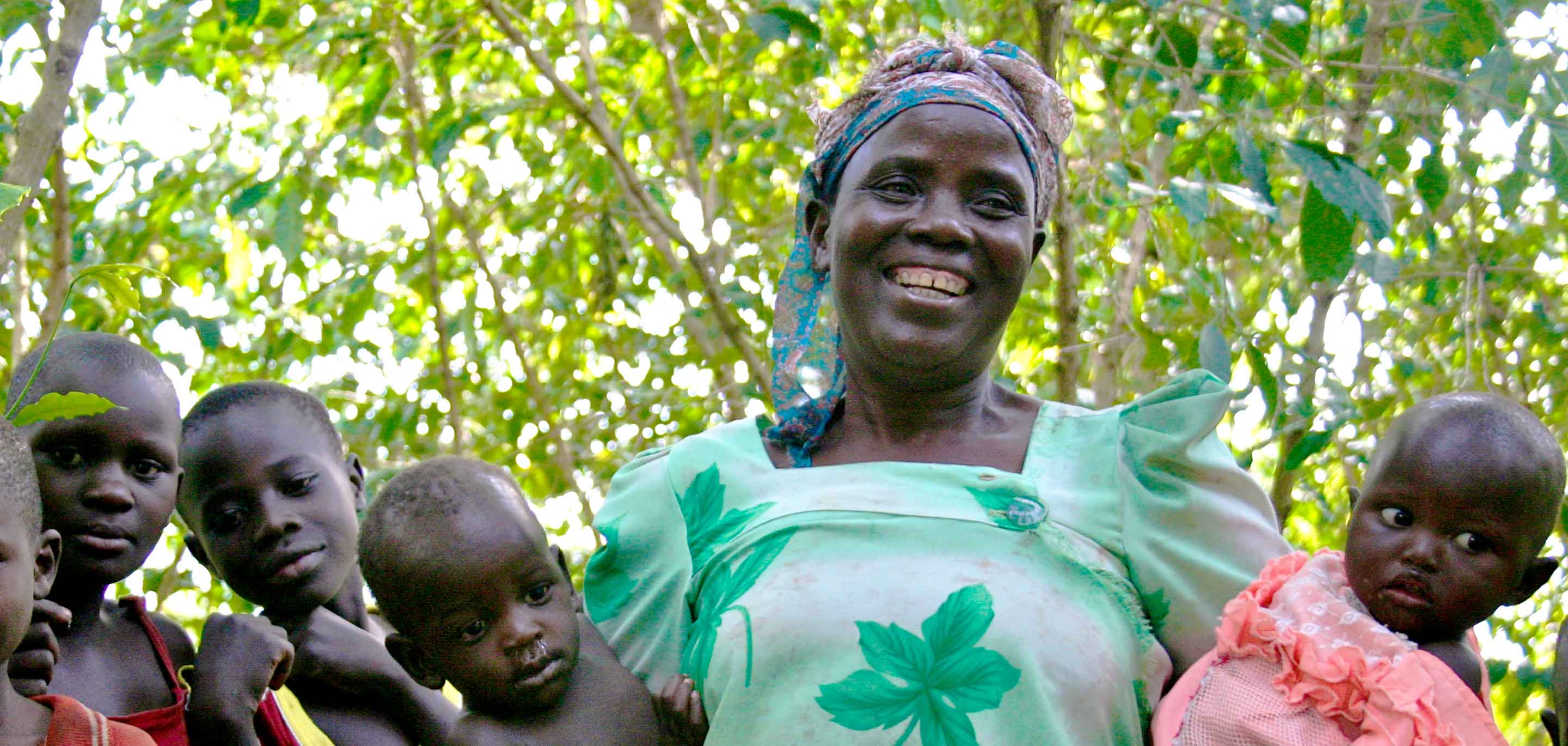
Banner: Florence Namaja Wabire, Coffee Farmer from Mirembe Kawomera, Uganda
A Cup That Carried More Than Coffee
When Paul Katzeff co-founded Thanksgiving Coffee in 1972, he carried with him the heart of a social worker who believed business could be a tool for justice. That vision led us, in the early 2000s, to a group of Jewish, Christian, and Muslim farmers in Mbale, Uganda. They called their cooperative Mirembe Kawomera—“Delicious Peace.”
For nearly two decades, we roasted their beans and shared their story. Each bag carried more than coffee; it carried proof that people of different faiths could work side by side, building better lives through collaboration.
What We Accomplished Together
With your purchases and support, Delicious Peace became more than a product—it became a movement.
- A $1 rebate per bag funded clean water filters for all 342 cooperative households, drastically reducing illness and freeing income for education and food.
- Clean Cook Stoves replaced traditional open-fire kitchens for the most vulnerable families, using one-tenth the fuel while directing smoke safely outside the home. These stoves reduced illness and burns, curbed deforestation, and became a model for climate resilience, women’s health, and rural job creation.
- Women and girls gained back hours of their days once spent collecting firewood.
- Most importantly, a community once divided grew into a living example of interfaith harmony.
For a dive deeper, the full journey is archived here:
Mirebe Kawomera, M'bale Uganda Photo by Paul Katzeff
Why Delicious Peace Coffee Is No Longer Available
We know this is disappointing news. Some of you first discovered Thanksgiving Coffee through Delicious Peace. We are grateful for every cup you brewed.
Over two decades, we built demand for this coffee from zero to 10,000 pounds a year. It wasn’t easy—the growth came through our own costly marketing of the interfaith story. But importing from Uganda required purchasing a full container, nearly 37,000 pounds. There was never a market for the remaining 27,000 pounds, so we absorbed the excess into other blends in order to keep bringing their coffee in.
Today, with a single container costing about $200,000, that model is no longer financially possible for us as a small, values-driven company. We had to rethink how we continue telling this inspirational interfaith coffee story without jeopardizing the health of our business. Rather than overextend ourselves financially and risk the integrity of our work, we chose to step back responsibly and allow the story to evolve in new ways.
The decision wasn’t easy. Delicious Peace was an extraordinary coffee grown in rich volcanic soil. But more than the flavor, it was the interfaith cooperation that made it truly special. And that is the part of the story that continues today.
Two Boys from Mirembe Kawamera peering out the window. Photo by Paul Katzeff
A New Chapter: Nabugoye Crafts
The spirit of Delicious Peace did not end when the coffee did. It found new soil, new forms, new voices.
One of the cooperative’s original founders, Sinina Namidosi, transformed her crochet skills into a thriving artisan collective. Visitors admired her headpieces—worn in both Muslim and Jewish traditions—and she began teaching other women. Soon, artisans across the community were creating beauty together across faith lines.
Living in rural Mbale meant limited market access. With seed funding from Thanksgiving Coffee and the entrepreneurial spirit of local partner John Elijah, the group registered a business, opened a bank account, and launched an online store. Today, Nabugoye Crafts ships worldwide.
👉 Visit Nabugoye Crafts
Each piece—whether a headpiece, accessory, or textile—carries the same message that once filled your cup: Jews, Christians, and Muslims working side by side, creating beauty, and sustaining their families with dignity.
No Substitution, Only Continuation
There is no true substitute for Delicious Peace. What made it extraordinary wasn’t only the beans, it was the unity behind them. That story now continues through Nabugoye Crafts. By supporting these artisans, you’re keeping the spirit of Delicious Peace alive—helping women earn income, sustain their households, and model interfaith harmony for the next generation.
Fun note: Smithsonian Folkways recording Delicious Peace: Coffee, Music and Interfaith Harmony in Uganda.
With Gratitude
To all who supported Delicious Peace over the years: thank you. You funded clean water, you stood for interfaith peace, and you proved that coffee can be a force for justice. While the coffee itself is no longer on our shelves, the story lives on—now in the hands of Ugandan women artisans whose work is as purposeful as it is beautiful.
With gratitude,
The Thanksgiving Coffee Family
Lavender Grace is the Sustainability Consultant for Thanksgiving Coffee Company
Delicious Peace Coffee: Honoring the Legacy, Continuing the Interfaith Journey
read more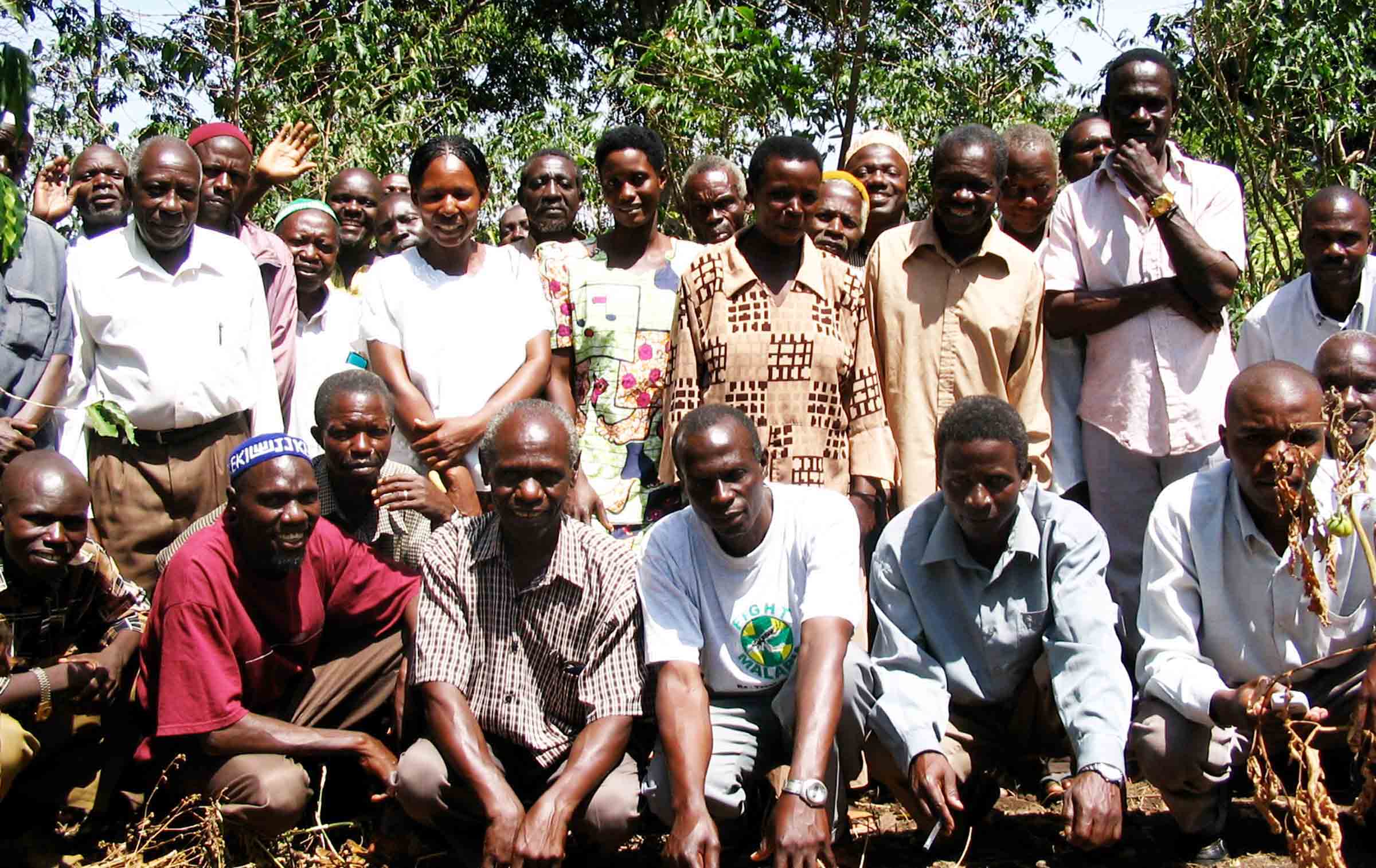
Namanyonyi Co-op united a community
The wheels were set in motion many years ago when Thanksgiving Coffee began our work with the Ugandan Coffee Cooperative “Delicious Peace” to bring their Interfaith coffee to market. For those of you who have been following us on this unique journey, we want to share another perspective. It is an article written by an organization that understands cooperatives are run by people, and people have many ups and downs.
"We love this story of multiple faiths helping each other, moving beyond personal beliefs"
Child from the "Delicious Peace" Coffee Cooperative in Uganda.
The author is Rebecca Harvey, the executive editor of Co-operative News. She was very intrigued about the journey this cooperative has been on and contacted Thanksgiving to learn about our involvement. We had the opportunity to speak with her and share our story. We also learned that Co-op News has been around for over 150 years to support the communication between all the many cooperatives in England, and now the World.
The Article For You To Read:
How A Coffee Co-op United A Community – And Was Reborn After A Leadership Crisis
More of our history with the Delicious Peace Cooperative:
2009: Delicious Peace Moves Forward
2014: A Trip To Africa
2020: Delicious Peace Coffee: A New Story
2023: Evolution of Change
Where it all began - the Delicious Peace Coffee
Namanyonyi Co-op United A Community
read more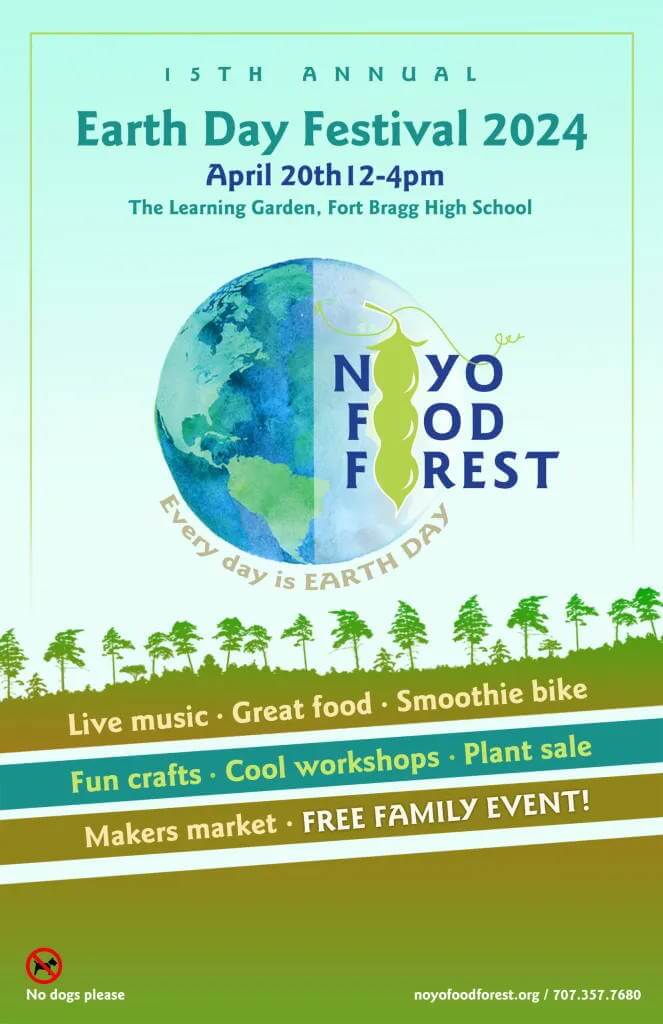
Earth Day Event in Fort Bragg
The Noyo Food Forest is having their annual Earth Day celebration this Saturday at the Learning Garden. This four hour event is a fundraiser for the Farm-to-School and Youth Intern programs that the Noyo Food Forest operates year-round. We partner with the Noyo Food Forest throughout the year, and we especially love being a part of this annual event in Fort Bragg.
15th Annual Earth Day Event
Saturday, April 20, 12 - 4 PM
At the Learning Garden at Fort Bragg High School on Dana Street.
This Earth Day event is free and geared toward everyone in the family. There will be live music, and you can participate by putting down a bid for the silent auction, paying entry to bouncy houses, and tasting goodies from local chefs. This is one of the most fun events that happens in the city of Fort Bragg every year. Local organizations and nonprofits are a big part of this event, and you’ll see booths and representatives from the Noyo Marine Science Center, the Mendocino Land Trust, our Mendocino County state parks and many more important parts of the coastal community.
Thanksgiving Coffee will be serving up samples of our Bee Bold Blend, our new Nitro Coffee, and the Noyo Food Forest will be selling 12oz bags, as well. All the proceeds benefit the Noyo Food Forest and their important work here in our community. We are very happy to be a part of this awesome event. For more information, visit the Noyo Food Forest Earth Day page on their website, and RSVP on Facebook to share with your friends. Join us on April 20 – see you at the Learning Garden.
Thanksgiving Coffee Company
Partnership with the Noyo Food Forest
Learn more about how we support our Mother Earth
Earth Day Event in Fort Bragg 2024
read more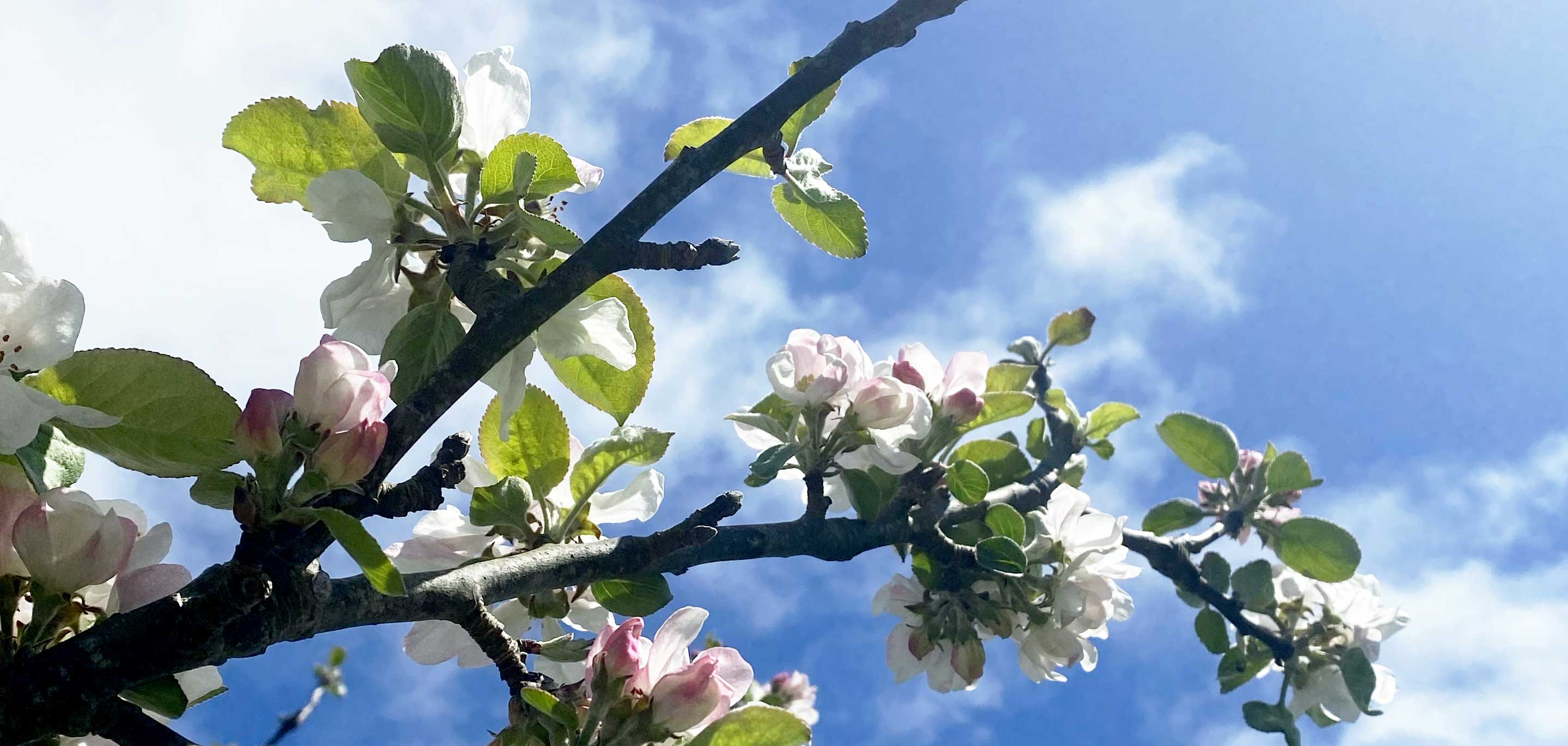
Our 2024 Impact Report
At Thanksgiving Coffee, every roast begins with a question: What really matters?
In 2024, we found answers by listening—to farmers, to customers, to our team, and to the land. The result is the most honest and grounded Impact Report (pdf) yet: a reflection of where we’ve been and where we’re headed next.
As we simplify our product line to focus on what we do best, we’re holding tight to the relationships and regenerative values that have always defined our work. That means sourcing from smallholder cooperatives, supporting ecological resilience, and roasting every bean with care and intention.
“Coffee, when done right, Is A Relationship.”
In 2024, we listened more deeply than ever:
⭐ 88.9% of our green coffee was Certified Organic
⭐ $91,529 donated to causes we care about
⭐ Verified health and income gains from clean energy investments in Uganda
⭐ Roasting with purpose for 52 years and counting
Our Ongoing Commitments
We remain committed to being ethically sourced and artisan roasted, maintaining over 88% of our coffees certified Organic, and guiding all purchases by our Purchasing for a Healthier Planet criteria. (This criteria was established in 1995 and is still going strong.)
While we're retiring many of our Cause Coffees this year, a few important ones will remain and their impact continues. From restoring pollinator habitat to protecting migratory bird forests, your daily cup still fuels change where it’s needed most.
Biodiversity loss is one of the most urgent challenges of our time, and we’re proud to stand with the growers, ecologists, and educators who are working to reverse it—one forest, one garden, one farm at a time.
Past Impact Reports
Lavender Grace is the Sustainability Consultant for Thanksgiving Coffee Company
Brewing Possibility: Our 2024 Impact Report
read more
Taste the Bright Future of Coffee
- Tasting Notes: Vibrant citrus, delicate florals, and a smooth honey finish
- Mouthfeel: Silky and refreshing, with a bright, clean finish
- Perfect for: Pour over, drip, or French press—ideal for your morning clarity ritual
Rwanda Single Origin Coffee with citrus, floral, and honey tasting notes from Dukunde Kawa.
Why Dukunde Kawa Coffee Matters
Dukunde Kawa means “Let’s love coffee”—a name that reflects their commitment to people, planet, and flavor. This Rwandan cooperative is internationally recognized for combining exceptional quality with climate action.
Climate Resilience in Action:
- 2,500+ Clean Cook stoves Installed, reducing wood use by 70%
- Tree Nurseries Restoring Biodiversity, combating soil erosion
- Women’s Leadership, with 80% women participation at the Ruli washing station
Rwanda coffee farm
Dukunde Kawa Sustainability Programs
Thanksgiving Coffee Dukunde Kawa Story
Every bag of Rwanda Single Origin supports these impactful programs, making every cup an act of regeneration and reciprocity.
Brew a Better Morning, Support a Better Future
- Support Healthier Homes with clean cook stove initiatives
- Restore Forests and Farms through reforestation efforts
- Empower Women Farmers, nurturing local leadership
Brewing Highlight: Cold Brew for Summer Brightness
Show off the bright notes of Rwanda Single Origin with this easy cold brew:
- Coarse grind 1 cup of beans
- Steep in 4 cups of filtered water for 12-14 hours
- Serve over ice with a twist of fresh orange peel
Lavender Grace is the Sustainable Ecology Advocate for Thanksgiving Coffee Company
Rwanda Resilience: Coffee with a Climate Impact
read more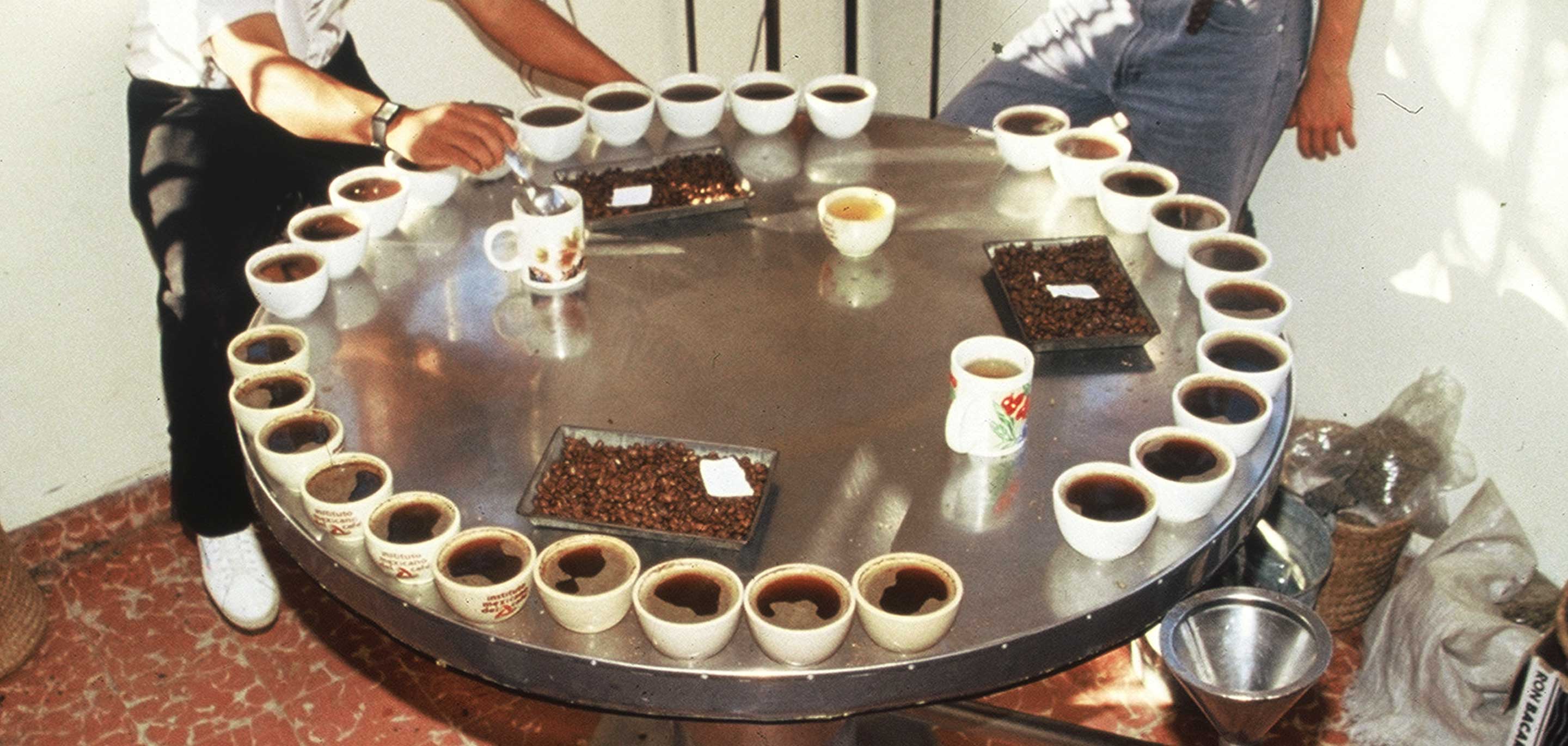
The Cupping Lab Revolution: How Thanksgiving Coffee Changed Coffee Forever
Cupping Coffee , Nicaragua
It began with a journey to Nicaragua in the 1980s. Paul Katzeff, a former social worker and co-founder of Thanksgiving Coffee, traveled to listen to the farmers. Paul had the tools and vision to create a new way forward for the coffee world.
In those war-torn hills, Paul came face to face with the quiet strength of farmers who had survived conflict, drought, and poverty. What he discovered would transform his understanding of coffee forever.
What Paul saw was that coffee could be more than just a product. It could become a tool for restoring dignity, building solidarity, and giving voice to those who had been left out of their own story.
Nicaruaguan Coffee Farmers coming home, photo by Paul Katzeff
Coffee as a Bridge Between Worlds
Paul's 1985 trip to Nicaragua occurred during the U.S.-backed Contra War—a time of immense hardship and tension. What he witnessed moved him deeply: farmers cultivating resilience amid unimaginable challenges. Meeting with PRODECOOP, one of the earliest farmer cooperatives, he understood that meaningful change would require more than charity. It would take genuine partnership.
This experience birthed a vision for direct trade built on empathy and transparency. Paul saw coffee as more than a commodity—he saw it as a bridge connecting people across borders, across struggles, and across systems built to exclude the voices of those who grow the coffee we love.
Coffee Processing Nicaragua
Preparing coffee to dry - Nicaragua
Roasting coffee in traditional oven at the Lopado Farm, Nicaragua, photo by Paul Katzeff
Grinding coffee in traditional outdoor style, photo by Paul Katzeff
A Revolution Born from Relationship
Years later, in 2001, Paul's vision took physical form when Thanksgiving Coffee helped create the world's first farmer-owned cupping labs. It started with a simple question:
What if those who grow the coffee were also the ones to taste it first?
That question sparked a revolution—and in partnership with our co-ops like UCA MIRAFLOR and CECOCAFEN, it redefined not just how coffee is evaluated, but who gets to define its value.
This work began with trust.
When Thanksgiving Coffee first partnered with these cooperatives, they were communities rising from hardship with their own vision. Families were replanting forests, rebuilding homes, and forming cooperatives that prioritized not only trade, but democracy, biodiversity, and food sovereignty.
Frank Lanzas Family
Fernandito Family
Fernando Beneficio
Maria Elena
As field researcher Christopher Bacon wrote:
"This is a story of reconstruction and resistance... of families working together to regenerate their communities, reclaim the land, and build new institutions of democratic governance."
In these post-war communities, farmers didn't just return to the land—they reimagined its future. By placing cupping labs in their hands, Thanksgiving Coffee wasn't introducing a new tool—they were honoring a movement already in motion.
Redefining the Waves: How Cupping Labs Transformed Coffee Culture
The history of specialty coffee is often described in "waves." The First Wave brought coffee to the masses. The Second Wave introduced espresso culture and coffee as an experience.
But it was the Third Wave—focused on origin, transparency, and craft—that truly began to value the farmer's role. And it was here that Thanksgiving Coffee's cupping labs created their most profound impact.
The Coffee Cuppers Manifesto, by Paul Katzeff 2001
"The $300,000 enabled 9 coops to build their labs and be trained as cuppers by me using SCAA scoring forms. It is one thing to have a lab but another thing to know how to use it. Training was essential. "
- Paul Katzeff
In 1999, when most coffee buyers still made quality decisions without farmer input, Thanksgiving Coffee proposed something radical: building professional cupping labs directly within producer cooperatives in Nicaragua. With a $300,000 USAID contract and decades of field experience, these labs were constructed in 2000, becoming the world's first farmer-owned and operated cupping facilities.
The innovation couldn't have been better timed. As Third Wave coffee culture was gaining momentum in the early 2000s with its focus on single-origin beans and transparent sourcing, these cupping labs equipped farmers to meet this new demand with unprecedented precision.
Suddenly, farmers could:
- Taste and analyze their own coffee before it left the farm
- Create detailed flavor profiles previously only done by importers
- Develop specific micro-lots for specialty markets
- Experiment with processing methods that enhanced quality
- Engage in price negotiations based on verifiable quality data
By 2001, the Cuppers Manifesto was born—a bilingual manual distributed to 10,000 Nicaraguan farmers and later shared with 8,000 producers in Colombia by the Colombian Coffee Federation.
Coffee Processing Nicaragua, photo by Paul Katzeff
From Third Wave to Fourth: Farmers as Flavor Artists
What began as a Third Wave innovation has evolved into something even more profound—what many now call the "Fourth Wave" of coffee, where farmers themselves have become recognized artists of flavor creation.
Today's most celebrated coffees often feature not just the region or farm name, but specific processing techniques developed and perfected by individual farmers—techniques like honey processing, extended fermentation, and anaerobic processing that create distinctive flavor profiles impossible to achieve through roasting alone.
This transition—from farmers as anonymous producers to farmers as named innovators—can be traced directly back to those first cupping labs. When farmers gained the ability to taste, evaluate, and experiment with their own coffee, they unleashed a wave of innovation that continues to transform the industry.
As Paul shared in a later interview:
"Coffee is about people. If you take care of the people, the coffee takes care of itself."
These labs didn't just reflect a shift in coffee culture—they helped create it. From these humble beginnings in rural Nicaragua grew the foundations of today's artisan coffee movement, where quality and value begin at the source and rise through shared craftsmanship.
UCA Miraflor Cooperative, 2023 Nicaragua
Hermanez Montenegro Family with drying coffee behind, photo by Paul Katzeff
A Legacy You Can Taste
SongBird Nicaraguan, Medium Roast
From UCA MIRAFLOR, this coffee represents the pinnacle of farmer-led quality development.
Bird Friendly certified, it supports both sustainable farming and migratory bird habitat.
Tasting Notes: Mango, nutty, chocolate
Miel de Cajamarca, Light Roast
From CENFROCAFE, Peru. Named for the honey-processing techniques refined in origin cupping labs.
This coffee showcases the artisan experimentation that defines Fourth Wave coffee.
Tasting Notes: Honey, papaya, milk chocolate
Join the Revolution in Your Cup
The Cupping Lab Revolution was more than the technology of tasting coffee. It was—and still is—about relationship, repair, and reclaiming the right to define what coffee can be.
Every cup of Thanksgiving Coffee connects you to this ongoing story of transformation—from Third Wave transparency to Fourth Wave farmer artisanship. It's an invitation to participate in a more equitable, relationship-based trade model that honors both the product and its producers.
It is about following a path with heart to let it guide you to be in good relationship with life and the world.
The Cupping Legacy continues - on the left, CEO Jonah Katzeff - on the right, Co-Founder and Board President Paul Katzeff of Thanksgiving Coffee Company
The Way
"The way to great coffee flavor is not direct.
The path must be traveled
with great care and attention.
The way becomes a path, the path a road,
and then, magically, the road becomes a highway
that leads to people who cultivate the land on which the coffee derives its special flavor.
How does one find the path? Through caring.
One does not search so much for the road that leads to the tree, as for the road that leads to the heart.
This is the secret."
Paul Katzeff
Co-founder, Thanksgiving Coffee Company
Lavender Grace is the Sustainability Consultant for Thanksgiving Coffee Company.
